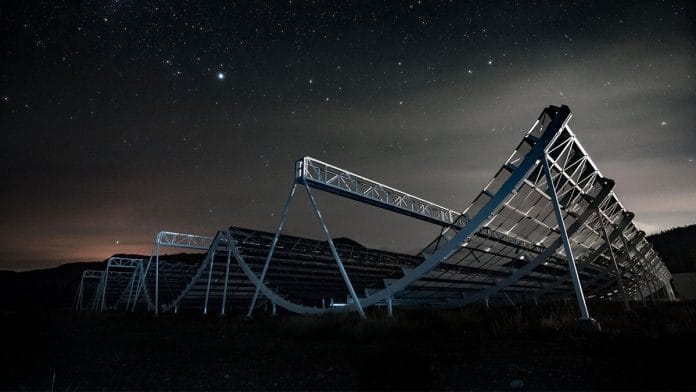Bengaluru: Astronomers have detected a bright fast radio burst, which lasted for a millisecond, from our galaxy for the first time ever.
Fast radio bursts (FRB) are bright bursts of radio waves from astronomical objects across galaxies, and their sources have been a mystery for over a decade.
This signal, called FRB 200428, was found in April inside the Milky Way galaxy for the first time and was also the first to be traced to a magnetar, which are dead stars that have the most powerful magnetic fields in the universe. The findings confirm that magnetars could be sources for FRBs.
The radio burst was also accompanied by X-rays, another first.
The FRB and subsequent X-ray radiation was observed by at least four telescopes. The findings were published in three papers (here , here , and here) in the journal Nature Wednesday.
Also read: ISRO to launch radar weather satellite Saturday, but no media, guests allowed due to Covid
FRB detected in April
On 28 April 2020, astronomers used the Astronomer’s Telegram service — an internet-based short-notice publication service for astronomical observations — to announce an FRB originating inside our galaxy, in a first-of-its-kind observation.
A day earlier, two space observatories, the Neil Gehrels Swift Observatory and the Fermi Gamma-ray Space Telescope, had detected multiple bursts of X-ray and gamma-ray emissions coming from the magnetar SGR 1935+2154 situated within our galaxy
The next day, the same region of sky was visible to two telescopes on land, the Canadian Hydrogen Intensity Mapping Experiment (CHIME) and the Survey for Transient Astronomical Radio Emission 2 (STARE2) array of three radio antennas, in the US, both of which detected an FRB in the region.
The CHIME team was the one to announce the detection and it was described in their study as an “unusually intense X-ray burst activity”. According to standard convention, the FRB was numbered 200428.
Other space telescopes like the European Space Agency’s INTEGRAL space telescope, Russia’s Konus detector on NASA’s Wind spacecraft, and China’s Insight space observatory, also detected an X-ray burst coming from the same location at the same time.
China’s Five-hundred-meter Aperture Spherical Radio Telescope (FAST) detected an FRB from the location, two days later.
Also read: ISRO-NASA satellite NISAR expected to be launched by 2022
Theories related to FRBs
FRBs were first discovered in 2007, when scientists combed through archival pulsar data. Pulsars refer to spherical, compact objects in the universe, which are about the size of a large city but contain more mass than the sun. They often look like flickering stars but are not actually stars.
Several FRBs have subsequently been observed and recorded, but little is known about them because the phenomenon is so short and unpredictable. They have been observed all over the sky, in several galaxies.
In the past decade, scientists have come up with new theories about the origin of these FRBs, including possible origins from neutron stars, which are formed from the powerful deathly explosion of high mass stars in a supernova. Magnetars are a type of neutron star and have long been considered potential sources of these FRBs.
Magnetars are known to produce jets of gamma rays and X-rays, which also last for mere milliseconds and carry a huge burst of energy. Researchers generally accepted that this meant they could produce FRBs as well.
Implications of discovery
FRB 200428 is the first fast radio burst with emissions other than radio waves. It is also the first to be associated with a magnetar, and the first to be observed within the Milky Way, making it the closest FRB to be ever observed.
It was spotted towards the galaxy’s centre in the constellation called Vulpecula, about 30,000 light years from the Earth. In about 1 millisecond, the magnetar emitted as much energy as the sun does in 30 seconds.
This observation answers a big question in the field of FRB study. Before the discovery of this FRB, the lack of accompanying radiation was slowly lending credence to the theory that magnetars may not be the sources of FRBs after all. However, the latest findings confirm the accompaniment of X-rays with FRBs, strengthening magnetar origin theory.
And yet, several questions remain. It is still a mystery how these bursts form and what phenomena drive these bright, rare, unpredictable radio bursts with X-rays and gamma-rays.
To understand this, scientists will need to perform detailed observations of galaxies that are engaged in rapid star formation nearby, to find events similar to FRB 200428.
The delay in FAST detecting the FRB, even though the Fermi Gamma-ray telescope detected multiple X-rays at the time, also raised questions about the creation and properties of these FRBs originating in magnetars.
Scientists now wonder if FRBs could also be directional and perhaps pointed away from the Earth at the time, evading detection.
The question of what creates FRBs and drives their sporadic detection is still a mystery requiring further study.
Also read: There is water on the Moon trapped in glass, much more accessible than thought, says NASA






